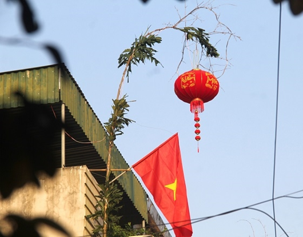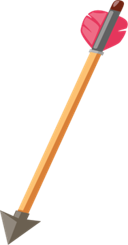Bài học cùng chủ đề
Báo cáo học liệu
Mua học liệu
Mua học liệu:
-
Số dư ví của bạn: 0 coin - 0 Xu
-
Nếu mua học liệu này bạn sẽ bị trừ: 2 coin\Xu
Để nhận Coin\Xu, bạn có thể:

Practice SVIP
Choose the correct answer to fill in blank (1).
Dear Sofia,
I hope you're doing well. I just came back from Vietnam, where I (1) __________ a traditional festival called Tet Nguyen Dan. It is the most important festival in Vietnam, and it celebrates the beginning of the lunar new year and the arrival of spring.
The festival lasted (2) __________ seven days, and it was full of fun and joy. We decorated the house with flowers, kumquat trees, peach blossoms, and red banners. We visited pagodas to pray for good fortune and health. We also visited our ancestors' graves and (3) __________ them food and incense.
The most exciting part of the festival was the New Year's Eve, when we watched the fireworks display and counted down to (4) __________ midnight. We also exchanged li xi as a way of wishing each other (5) __________ and prosperity. The next day, we visited our relatives and friends, and enjoyed delicious dishes.
The festival was a wonderful (6) __________ that I will never forget. I learned a lot about the Vietnamese culture and traditions. I took many photos and videos that I will show you when we meet.
I miss you a lot and I can't wait to see you soon.
Kate
Choose the correct answer to fill in blank (2).
Dear Sofia,
I hope you're doing well. I just came back from Vietnam, where I (1) __________ a traditional festival called Tet Nguyen Dan. It is the most important festival in Vietnam, and it celebrates the beginning of the lunar new year and the arrival of spring.
The festival lasted (2) __________ seven days, and it was full of fun and joy. We decorated the house with flowers, kumquat trees, peach blossoms, and red banners. We visited pagodas to pray for good fortune and health. We also visited our ancestors' graves and (3) __________ them food and incense.
The most exciting part of the festival was the New Year's Eve, when we watched the fireworks display and counted down to (4) __________ midnight. We also exchanged li xi as a way of wishing each other (5) __________ and prosperity. The next day, we visited our relatives and friends, and enjoyed delicious dishes.
The festival was a wonderful (6) __________ that I will never forget. I learned a lot about the Vietnamese culture and traditions. I took many photos and videos that I will show you when we meet.
I miss you a lot and I can't wait to see you soon.
Kate
Choose the correct answer to fill in blank (3).
Dear Sofia,
I hope you're doing well. I just came back from Vietnam, where I (1) __________ a traditional festival called Tet Nguyen Dan. It is the most important festival in Vietnam, and it celebrates the beginning of the lunar new year and the arrival of spring.
The festival lasted (2) __________ seven days, and it was full of fun and joy. We decorated the house with flowers, kumquat trees, peach blossoms, and red banners. We visited pagodas to pray for good fortune and health. We also visited our ancestors' graves and (3) __________ them food and incense.
The most exciting part of the festival was the New Year's Eve, when we watched the fireworks display and counted down to (4) __________ midnight. We also exchanged li xi as a way of wishing each other (5) __________ and prosperity. The next day, we visited our relatives and friends, and enjoyed delicious dishes.
The festival was a wonderful (6) __________ that I will never forget. I learned a lot about the Vietnamese culture and traditions. I took many photos and videos that I will show you when we meet.
I miss you a lot and I can't wait to see you soon.
Kate
Choose the correct answer to fill in blank (4).
Dear Sofia,
I hope you're doing well. I just came back from Vietnam, where I (1) __________ a traditional festival called Tet Nguyen Dan. It is the most important festival in Vietnam, and it celebrates the beginning of the lunar new year and the arrival of spring.
The festival lasted (2) __________ seven days, and it was full of fun and joy. We decorated the house with flowers, kumquat trees, peach blossoms, and red banners. We visited pagodas to pray for good fortune and health. We also visited our ancestors' graves and (3) __________ them food and incense.
The most exciting part of the festival was the New Year's Eve, when we watched the fireworks display and counted down to (4) __________ midnight. We also exchanged li xi as a way of wishing each other (5) __________ and prosperity. The next day, we visited our relatives and friends, and enjoyed delicious dishes.
The festival was a wonderful (6) __________ that I will never forget. I learned a lot about the Vietnamese culture and traditions. I took many photos and videos that I will show you when we meet.
I miss you a lot and I can't wait to see you soon.
Kate
Choose the correct answer to fill in blank (5).
Dear Sofia,
I hope you're doing well. I just came back from Vietnam, where I (1) __________ a traditional festival called Tet Nguyen Dan. It is the most important festival in Vietnam, and it celebrates the beginning of the lunar new year and the arrival of spring.
The festival lasted (2) __________ seven days, and it was full of fun and joy. We decorated the house with flowers, kumquat trees, peach blossoms, and red banners. We visited pagodas to pray for good fortune and health. We also visited our ancestors' graves and (3) __________ them food and incense.
The most exciting part of the festival was the New Year's Eve, when we watched the fireworks display and counted down to (4) __________ midnight. We also exchanged li xi as a way of wishing each other (5) __________ and prosperity. The next day, we visited our relatives and friends, and enjoyed delicious dishes.
The festival was a wonderful (6) __________ that I will never forget. I learned a lot about the Vietnamese culture and traditions. I took many photos and videos that I will show you when we meet.
I miss you a lot and I can't wait to see you soon.
Kate
Choose the correct answer to fill in blank (6).
Dear Sofia,
I hope you're doing well. I just came back from Vietnam, where I (1) __________ a traditional festival called Tet Nguyen Dan. It is the most important festival in Vietnam, and it celebrates the beginning of the lunar new year and the arrival of spring.
The festival lasted (2) __________ seven days, and it was full of fun and joy. We decorated the house with flowers, kumquat trees, peach blossoms, and red banners. We visited pagodas to pray for good fortune and health. We also visited our ancestors' graves and (3) __________ them food and incense.
The most exciting part of the festival was the New Year's Eve, when we watched the fireworks display and counted down to (4) __________ midnight. We also exchanged li xi as a way of wishing each other (5) __________ and prosperity. The next day, we visited our relatives and friends, and enjoyed delicious dishes.
The festival was a wonderful (6) __________ that I will never forget. I learned a lot about the Vietnamese culture and traditions. I took many photos and videos that I will show you when we meet.
I miss you a lot and I can't wait to see you soon.
Kate
Look and complete the words.

There is a b p in front of the house.
1. Vietnamese people have a custom of putting up a bamboo pole, known as “Cây Nêu”, in front of their house on the last day of the lunar year. The tree is supposed to scare off evil spirits during the absence of the Kitchen Gods during Tet. The decorations on the bamboo pole vary between regions and periods. Bows, arrows, bells, and gongs are often hung on the treetop.
2. Legend has it that a long time ago, devils occupied the land of humans. Seeing humans' suffering, the Buddha helped them fight the devils and forced them to come back to the sea. However, the devils were still allowed to come back to the mainland to visit their ancestors' grave for a few days during Tet. The Buddha taught humans to raise a high bamboo pole in front of each house to signal the devils that the land belonged to humans. The higher the bamboo tree was, the further the devils would stay away.
3. The bamboo pole is removed after the seventh day of Tet. This is the last ritual, which brings an end to the New Year celebration.
Read the passage and choose the correct answer.
Vietnamese people put up the bamboo pole to __________.
1. Vietnamese people have a custom of putting up a bamboo pole, known as “Cây Nêu”, in front of their house on the last day of the lunar year. The tree is supposed to scare off evil spirits during the absence of the Kitchen Gods during Tet. The decorations on the bamboo pole vary between regions and periods. Bows, arrows, bells, and gongs are often hung on the treetop.
2. Legend has it that a long time ago, devils occupied the land of humans. Seeing humans' suffering, the Buddha helped them fight the devils and forced them to come back to the sea. However, the devils were still allowed to come back to the mainland to visit their ancestors' grave for a few days during Tet. The Buddha taught humans to raise a high bamboo pole in front of each house to signal the devils that the land belonged to humans. The higher the bamboo tree was, the further the devils would stay away.
3. The bamboo pole is removed after the seventh day of Tet. This is the last ritual, which brings an end to the New Year celebration.
Read the passage and choose the correct answer.
Which of the following is NOT mentioned as a decoration on the bamboo pole?



1. Vietnamese people have a custom of putting up a bamboo pole, known as “Cây Nêu”, in front of their house on the last day of the lunar year. The tree is supposed to scare off evil spirits during the absence of the Kitchen Gods during Tet. The decorations on the bamboo pole vary between regions and periods. Bows, arrows, bells, and gongs are often hung on the treetop.
2. Legend has it that a long time ago, devils occupied the land of humans. Seeing humans' suffering, the Buddha helped them fight the devils and forced them to come back to the sea. However, the devils were still allowed to come back to the mainland to visit their ancestors' grave for a few days during Tet. The Buddha taught humans to raise a high bamboo pole in front of each house to signal the devils that the land belonged to humans. The higher the bamboo tree was, the further the devils would stay away.
3. The bamboo pole is removed after the seventh day of Tet. This is the last ritual, which brings an end to the New Year celebration.
Read the passage and choose the correct answer.
The word “them” in paragraph 2 refers to __________.
1. Vietnamese people have a custom of putting up a bamboo pole, known as “Cây Nêu”, in front of their house on the last day of the lunar year. The tree is supposed to scare off evil spirits during the absence of the Kitchen Gods during Tet. The decorations on the bamboo pole vary between regions and periods. Bows, arrows, bells, and gongs are often hung on the treetop.
2. Legend has it that a long time ago, devils occupied the land of humans. Seeing humans' suffering, the Buddha helped them fight the devils and forced them to come back to the sea. However, the devils were still allowed to come back to the mainland to visit their ancestors' grave for a few days during Tet. The Buddha taught humans to raise a high bamboo pole in front of each house to signal the devils that the land belonged to humans. The higher the bamboo tree was, the further the devils would stay away.
3. The bamboo pole is removed after the seventh day of Tet. This is the last ritual, which brings an end to the New Year celebration.
Read the passage and choose the correct answer.
The word “signal” in paragraph 2 is closest in meaning to __________.
1. Vietnamese people have a custom of putting up a bamboo pole, known as “Cây Nêu”, in front of their house on the last day of the lunar year. The tree is supposed to scare off evil spirits during the absence of the Kitchen Gods during Tet. The decorations on the bamboo pole vary between regions and periods. Bows, arrows, bells, and gongs are often hung on the treetop.
2. Legend has it that a long time ago, devils occupied the land of humans. Seeing humans' suffering, the Buddha helped them fight the devils and forced them to come back to the sea. However, the devils were still allowed to come back to the mainland to visit their ancestors' grave for a few days during Tet. The Buddha taught humans to raise a high bamboo pole in front of each house to signal the devils that the land belonged to humans. The higher the bamboo tree was, the further the devils would stay away.
3. The bamboo pole is removed after the seventh day of Tet. This is the last ritual, which brings an end to the New Year celebration.
Read the passage and choose the correct answer.
Which of the following is true according to the passage?
1. The Cau Ngu Festival is a traditional festival that honors the whale, which is considered as the guardian of the fishermen in many coastal provinces in Vietnam. The festival is held annually in the first lunar month.
2. The origin of the festival dates back to ancient times, when the fishermen believed that the whale protected them from storms and sea monsters. Whenever a whale died, the villagers would bury it with respect and gratitude. They would also build a temple to worship the whale's bones.
3. The Cau Ngu Festival consists of two parts: the ceremonial rituals and the festive activities. The ceremonial rituals include offering incense, flowers, fruit, and food to the whale, praying for good luck, safety, and prosperity, and parading the whale skeleton or statue through the streets. The festive activities include various folk games and performances, such as boat racing, lion dancing, and singing.
4. The Cau Ngu Festival is a unique cultural feature of Vietnam that reflects the close relationship between the people and the sea. The festival also preserves and promotes the traditional values of the coastal communities in Vietnam.
Read the passage and choose the correct answer.
What is the text mainly about?
1. The Cau Ngu Festival is a traditional festival that honors the whale, which is considered as the guardian of the fishermen in many coastal provinces in Vietnam. The festival is held annually in the first lunar month.
2. The origin of the festival dates back to ancient times, when the fishermen believed that the whale protected them from storms and sea monsters. Whenever a whale died, the villagers would bury it with respect and gratitude. They would also build a temple to worship the whale's bones.
3. The Cau Ngu Festival consists of two parts: the ceremonial rituals and the festive activities. The ceremonial rituals include offering incense, flowers, fruit, and food to the whale, praying for good luck, safety, and prosperity, and parading the whale skeleton or statue through the streets. The festive activities include various folk games and performances, such as boat racing, lion dancing, and singing.
4. The Cau Ngu Festival is a unique cultural feature of Vietnam that reflects the close relationship between the people and the sea. The festival also preserves and promotes the traditional values of the coastal communities in Vietnam.
Read the passage and choose the correct answer.
The whale __________.
1. The Cau Ngu Festival is a traditional festival that honors the whale, which is considered as the guardian of the fishermen in many coastal provinces in Vietnam. The festival is held annually in the first lunar month.
2. The origin of the festival dates back to ancient times, when the fishermen believed that the whale protected them from storms and sea monsters. Whenever a whale died, the villagers would bury it with respect and gratitude. They would also build a temple to worship the whale's bones.
3. The Cau Ngu Festival consists of two parts: the ceremonial rituals and the festive activities. The ceremonial rituals include offering incense, flowers, fruit, and food to the whale, praying for good luck, safety, and prosperity, and parading the whale skeleton or statue through the streets. The festive activities include various folk games and performances, such as boat racing, lion dancing, and singing.
4. The Cau Ngu Festival is a unique cultural feature of Vietnam that reflects the close relationship between the people and the sea. The festival also preserves and promotes the traditional values of the coastal communities in Vietnam.
Read the passage and choose the correct answer.
When a whale died, people would __________.
1. The Cau Ngu Festival is a traditional festival that honors the whale, which is considered as the guardian of the fishermen in many coastal provinces in Vietnam. The festival is held annually in the first lunar month.
2. The origin of the festival dates back to ancient times, when the fishermen believed that the whale protected them from storms and sea monsters. Whenever a whale died, the villagers would bury it with respect and gratitude. They would also build a temple to worship the whale's bones.
3. The Cau Ngu Festival consists of two parts: the ceremonial rituals and the festive activities. The ceremonial rituals include offering incense, flowers, fruit, and food to the whale, praying for good luck, safety, and prosperity, and parading the whale skeleton or statue through the streets. The festive activities include various folk games and performances, such as boat racing, lion dancing, and singing.
4. The Cau Ngu Festival is a unique cultural feature of Vietnam that reflects the close relationship between the people and the sea. The festival also preserves and promotes the traditional values of the coastal communities in Vietnam.
Read the passage and choose the correct answer.
The word “promotes” in paragraph 3 is closest in meaning to __________.
1. The Cau Ngu Festival is a traditional festival that honors the whale, which is considered as the guardian of the fishermen in many coastal provinces in Vietnam. The festival is held annually in the first lunar month.
2. The origin of the festival dates back to ancient times, when the fishermen believed that the whale protected them from storms and sea monsters. Whenever a whale died, the villagers would bury it with respect and gratitude. They would also build a temple to worship the whale's bones.
3. The Cau Ngu Festival consists of two parts: the ceremonial rituals and the festive activities. The ceremonial rituals include offering incense, flowers, fruit, and food to the whale, praying for good luck, safety, and prosperity, and parading the whale skeleton or statue through the streets. The festive activities include various folk games and performances, such as boat racing, lion dancing, and singing.
4. The Cau Ngu Festival is a unique cultural feature of Vietnam that reflects the close relationship between the people and the sea. The festival also preserves and promotes the traditional values of the coastal communities in Vietnam.
Read the passage and choose the correct answer.
It can be inferred from the passage that the Cau Ngu Festival __________.
Write letters A – E in the blanks 1 – 4 to complete the conversation. There is ONE extra letter.
A. He's very wise and kind.
B. I'm looking forward to it.
C. It's a big milestone for him and our family.
D. I'm sure he'll appreciate your love and respect.
E. It's the best party I've ever attended.
Nhung: Hey, are you free this weekend? I want to invite you to my grandfather's longevity party.
Vicky: Sure, I'd love to join. How old is your grandfather this year?
Nhung: He's turning 80. (1)
Vicky: Wow, that's amazing. He must be very happy and proud of his children and grandchildren.
Nhung: He is. He always tells us stories about his life and gives us advice. (2)
Vicky: I admire him a lot. What are you going to do for the party?
Nhung: Well, we're going to prepare some traditional dishes, such as bánh chưng, thịt kho, and xôi gấc. We're also going to give him some gifts, such as red envelopes, flowers, and fruits.
Vicky: That sounds wonderful. (3)
Nhung: Thank you. I hope you can come and celebrate with us. It'll be fun and meaningful.
Vicky: Of course, I will. (4) See you soon!
Write letters A – F in the blanks 1 – 5 to complete the conversation. There is ONE extra letter.
A. We've made some beautiful lanterns in different shapes.
B. They reflect the values and culture of Vietnam.
C. I prefer the ones with green bean paste and coconut.
D. Maybe we can meet up later and share our experiences.
E. I love watching the moon and eating moon cakes with my family and friends.
F. I heard they have some amazing performers this year.
Mary: Hey, do you know what day is today?
Tom: Of course, I do. It's the Mid-Autumn Festival, one of my favourite festivals.
Mary: Me too. (1)
Tom: What kind of moon cakes do you like best?
Mary: I like the ones with lotus seed paste and salted egg yolk. How about you?
Tom: (2)
Mary: Well, to each their own. Do you have any plans for tonight?
Tom: Yes, I'm going to join a lantern parade with some kids from my neighborhood. (3)
Mary: That sounds fun. I'm going to watch a lion dance at the park. (4)
Tom: Wow, that sounds exciting. (5)
Mary: Sure, that would be great. Happy Mid-Autumn Festival!
Tom: Happy Mid-Autumn Festival to you too!
Write numbers 1 – 6 in the blanks to make a complete conversation.
Hi. Do you have any plans for tomorrow?
Yes, I do. It's a festival that celebrates Saint Giong, a great hero in Vietnam. He defeated the An invaders when he was only three years old.
Yes, I do. I'm going to attend the Saint Giong Festival in Phu Dong village. Do you know about this festival?
That's incredible. What do people do at the festival?
That's right. He grew up very fast and rode a giant iron horse into battle. He used bamboo trees as his weapons and burned the enemies with his horse's breath.
Well, he flew to heaven with his horse from Soc Son Mountain. He left his footprints and his horse's hoofprints on the rocks there.
Wow, that's amazing. What happened to him after the victory?
They reenact the battle scenes with flags, drums and gongs. They also carry a bamboo statue of Saint Giong around the village and worship him at the temple. They also take part in some traditional games and performances.
That sounds very interesting.

Bạn có thể đăng câu hỏi về bài học này ở đây
